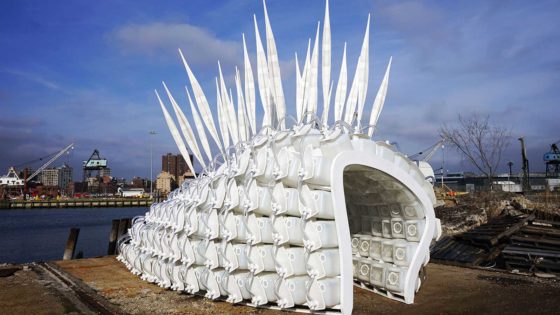New MODA Exhibition Aims To Spark Conversation About How Creatives Can Impact Climate Change

Terreform One, Cricket Shelter.
Courtesy of Terreform One
While conversations around climate change often focus on the future, the effects of Earth’s rising temperature have unequivocally made themselves felt in the present. A new exhibition at the Museum of Design Atlanta (MODA) addresses how designers can help reduce the devastating impacts of climate change: “Survival Architecture and the Art of Resilience.” The traveling art show was created by Art Works for Change, a nonprofit founded by Randy Jayne Rosenberg. She also curated the exhibition’s featured designers, and recently joined “City Lights” host Lois Reitzes via Zoom to talk about their contributions and what design can mean to the future of climate-conscious living.
The exhibition divides its artwork into four sections. “Circular” focuses on design using reusable materials, and “Portable” shows architectural designs for nomadic dwellings and shelters. “We initiated this around shelter in response to climate change, but… we’re in Oakland, California, and there’s such a big issue around homelessness for so many different reasons, and this really addresses refugees and homelessness,” said Rosenberg.
The third section, “Visionary,” has a more open-ended theme, offering works with creative flourish as well as strategic speculation toward the future. “We weren’t necessarily looking for designs and creations that could be functional, as much as just pushing the boundaries; thinking expansively, thinking visionary,” Rosenberg said. The fourth section, “Resilient,” displays shelter designs already in distribution, including IKEA’s “Better Shelter” that aided Syrian refugees with adaptable, movable, solar-powered dwellings.
Rosenberg described an unusual, and particularly resourceful design featured in the show, the “Cricket Shelter:” a mobile solution to food insecurity for its theoretical inhabitants. “It’s set up with a hygiene system for crickets to reproduce. They need the human body temperature to warm up their environment so they can reproduce, and in a lot of countries, crickets are a source of protein… It doesn’t require the resources that cattle or a lot of animal-sourced protein requires,” said Rosenberg. “It’s very economical.”
“Survival Architecture and the Art of Resilience” gives space to explore affordable housing, given the special challenge climate instability poses to populations living in poverty. One example, “Cardboard Origami,” presents flexible temporary housing structures made of augmented cardboard, that can help unhoused people achieve periodic stability as they may be searching for employment, care or security. The exhibition also checks in with the progress of trending housing concepts like “tiny homes” and converted shipping containers.
Rosenberg’s organization Art Works for Change, founded in 2008, curates traveling art experiences that bring communities into conversation about the changing environment, and facilitate climate action efforts in their host cities. “We do create these exhibitions that are content-driven, but we do ask the host museum to reach out to the community, and use the exhibition as a physical platform to draw the resources [that are] within the community already,” said Rosenberg.
“There are still people who believe that climate change, the climate crisis, is not really something that exists. So… we don’t want to focus on the problem. Our whole approach is really to be visionary, and ‘Where can we go from here?’” said Rosenberg. “By partnering with community through the museums, we’re hoping that groups who have made their mission 100 percent around climate, resilience, and housing, will make their resources known so that people can go within the community and explore the resources that are there.”
“Survival Architecture and the Art of Resilience” opens Aug. 27, at the Museum of Design Atlanta. Tickets and information can be found at www.museumofdesign.org/survival-architecture.








